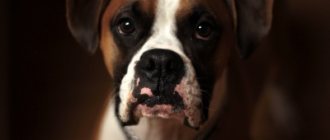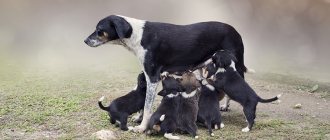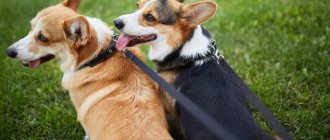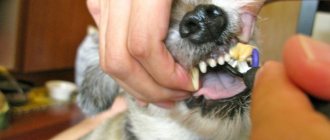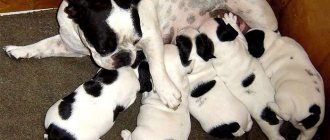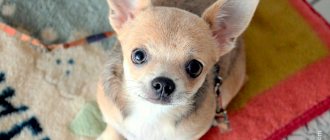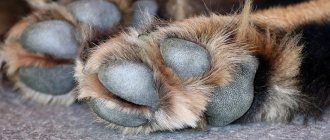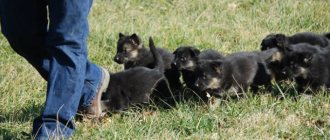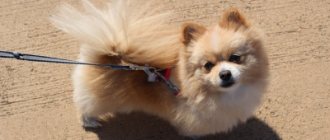Sneezing – this is a protective reaction of the body, with the help of which the dog removes various pathogenic microorganisms, mucus and foreign particles from the nasopharynx. Sneezing and snorting in a dog is not a mandatory symptom of any disease, but if the dog sneezes too often, and even more so if additional symptoms of the disease appear, then the cause of this phenomenon should be identified as soon as possible and eliminated. A lot of things can cause sneezing, and it’s worth considering the most common ones.
Causes of sneezing in dogs
Sneezing in a dog can cause:
- Hypothermia of the body.
- Rhinitis.
- Infection.
- Allergy.
- Injury.
- Heart diseases.
- Foreign body.
If your dog sneezes during a walk, do not rush to sound the alarm; single sneezes are quite acceptable. Everyone knows that a dog smells everything, as a result of which dust, earth, seeds or pollen, etc. often end up in the dog’s nose. If a dog’s sneezing becomes frequent and other symptoms are added, the dog’s owner will need to figure out why the dog is sneezing, whether there is any disease, and whether it is worth taking the dog to a veterinary clinic.
What is reverse sneezing?
If the owner of a brachycephalic breed does not know what this means, then when his dog begins to sneeze and snort through his nose, as if in a fit, he falls into real horror. When reverse sneezing, the animal bends in an unnatural position, throws its head back and tries to draw air through its lips without opening its jaw. Throughout the attack, the body shudders in convulsions. Despite the rather scary picture, the pet’s condition is completely normalized after 15-30 seconds.
This frightening phenomenon occurs with a spasm of the larynx, characteristic of brachycephalic dogs with a skull deformed as a result of selection. It affects Pekingese, Bulldogs, Pugs, Shih Tzus and Boxers.
In most cases, you just have to come to terms with such a strange feature, since it does not threaten the life and health of the animal. You should seek help only if attacks become more frequent and your health becomes steadily worse. With such symptoms, surgery is required to ease breathing.
Entry of foreign bodies into the nasal cavity
While walking, dogs explore with their noses everything they encounter along the way. If your dog, while walking, starts snorting and sneezing, waving his head, or rubbing his nose with his paw, then there is a high probability that something has gotten into his nose. There may be blood and copious mucous discharge from the nose. In such a case, the dog owner urgently needs to examine its nose and try to remove any foreign objects with tweezers. If this cannot be done, the dog must be urgently taken to a veterinary clinic to remove foreign objects from the nasal cavity.
Polyps or tumors in the animal's nasal cavity
Constant sniffing is caused by the appearance of tumors in the nasal passages of a pet. Neoplasms can be benign or malignant. Associated symptoms are noted:
- The animal has noisy breathing.
- A profuse discharge mixed with blood or pus comes out of the nose.
- A small bump or thickening is clearly visible on the affected side.
Gradually, the polyp is able to increase in size until it completely blocks the lumen of the animal’s nasal passage.
Treatment of neoplasms is only surgical in a veterinary clinic. The intervention is performed under general anesthesia. The doctor has the right to recommend a histological examination of the removed tissue to exclude a malignant tumor. If the conclusion is unfavorable, chemotherapy with antitumor drugs is prescribed. The prognosis for detecting a cancerous tumor in a dog looks questionable or unfavorable.
Hypothermia of the body
With a sudden change in ambient temperature, when there is a sharp narrowing or expansion of the blood vessels of the nasal cavity, the dog may begin to sneeze. Most often, dog owners notice this phenomenon in winter, when they return from a walk to a warm apartment, or vice versa, when a dog leaves a warm apartment in the cold.
This is a normal physiological reaction of the body and should not bother the owner. For those dog breeds that have a small coat of hair, in order to prevent hypothermia in the winter, owners must purchase special clothing for walking.
Nowadays, with the abundance of various clothes for dogs, for dogs with short hair, walking without clothes in cold weather is considered wrong. Therefore, if you want to take a walk with your dog in winter, you need to purchase a so-called “dog coat” or avoid walking in cold weather.
The opinion of some owners that the nature of the dog has provided for everything in this regard is considered completely wrong. This is true for those dogs who live in summer cottages, in rural areas in their kennels on the street. In large metropolitan areas, most dog owners keep them in their warm apartment. Dogs living on the street and in apartments react differently to the cold.
If after a walk you notice that your pet has begun to sneeze, cough, is chilling and is trying to find a warmer place in the apartment, then this indicates that the dog has suffered from hypothermia.
With severe hypothermia, the visible mucous membranes become pale, and sometimes blisters appear on the pads, tips of the ears and genitals (2nd degree frostbite). The dog's body temperature begins to decrease.
In this situation, you will need to take care of your pet by providing it with “dry warmth” - wrap it in a blanket, place a heating pad on the paw area and contact a veterinarian for advice by phone.
What is sneezing and its functions
Sneezing is a physiological process in which air is expelled through the nasal cavity during forced exhalation. This is the most important protective reflex, the center of which is located in the medulla oblongata. Using this process, the animal's body reacts to any irritant that gets on the mucous membrane of the nasal passages.
When dust particles (or other irritants) enter the nasal mucosa, the nerve endings transmit a signal to the medulla oblongata. From there, a response occurs - breathing stops for a few seconds, a deep breath occurs, and then the diaphragm and intercostal muscles contract, provoking a strong, rapid exhalation.
When sneezing, the tongue is pressed against the soft palate, so a sharp exhalation occurs through the nose. This process differs from coughing.
Rhinitis or runny nose
Rhinitis in dogs is accompanied by sneezing. In dogs, at the beginning of the disease, colorless snot appears, which has a liquid consistency, later its consistency becomes thicker. The dog tries to wipe its nose with its paws and often licks itself. As the disease progresses, the dog's nasal discharge will become thicker, causing crusts to form in the nose, making it difficult for the dog to breathe, causing the dog to sniffle and sometimes breathe through the mouth. Mixed dyspnea may occur in some dogs. The nasal mucosa is reddened. If rhinitis is an independent disease, then there are no changes in the general condition of the dog’s body, and the dog retains a good appetite. For more details, see our article - runny nose in dogs.
Why sneezing can be dangerous
Frequent sneezing with coughing or snorting cannot be ignored. Due to irritation of the mucous membrane, breathing may be difficult, the nose may swell, which will lead to insufficient filtration of the nasal sinuses and bacteria will multiply in them.
Common reasons:
- Allergy
- Hypothermia
- Diseases: nasopharyngeal tumor, infection, rhinitis
- Congenital pathology
- Age characteristics
A dog sneezes as a symptom of a disease
If the dog often sneezes and grunts, wheezes, rubs its muzzle, tries to inhale forcefully, but there were no injuries and the entry of a pebble, seed, or other foreign body is excluded, then the cause may be a polyp or tumor in the nasopharynx. To determine the type of tumor, a biopsy must be performed. After this, treatment will be prescribed.
Also, this behavior may be due to the presence of infection in the body. If your pet is sneezing, thirsty, coughing, wheezing during sleep, or showing no interest in food, he may have an infection. Other symptoms include vomiting, diarrhea, runny nose, and conjunctivitis. The infection cannot be treated at home. If you ignore such signs, it can be very dangerous for your dog.
It is necessary to have the animal examined by a doctor as soon as possible and adhere to the prescribed course of treatment. Rhinitis can also cause a dog to sneeze. As a rule, this process is caused by hypothermia, and greenish pus is released from the dog’s nose. Also, with rhinitis, crusts form on the nose, which can be lubricated with Vaseline.
Streptocide powder can be blown into the nose with caution. Rhinitis is usually not dangerous, and if your pet's appetite remains normal, it will go away within a week. If this does not happen, the disease can develop into chronic rhinitis.
Your dog may also catch a cold. Dogs, just like people, are susceptible to colds, especially during the cold season. It may be a minor cold, but sometimes a sneeze is associated with a serious illness. For example, a dog may cough and sneeze due to pneumonia, bronchitis, and experience severe shortness of breath.
The dangerous disease distemper can also be accompanied by sneezing. The animal becomes lethargic and timid, appetite decreases, and discharge appears from the eyes. The dog constantly sneezes and snorts due to inflammation of the mucous membrane of the respiratory tract; this should not be confused with reverse sneezing.
Allergy
Dogs see the world around them mostly through their nose; dogs have a highly developed sense of smell (smell in dogs). In modern life, when in recent decades a large number of artificial odors have appeared, plus an additionally extremely difficult environmental situation, especially around large cities, dogs with allergies, like people with allergies, are not uncommon.
The following can serve as an allergy agent for dogs:
- Household chemicals (washing powder, deodorants), perfumes, perfumes, etc.
- Pollen is a strong allergen for dogs; in the spring, dogs often develop seasonal allergies to certain plants.
- Mold.
- Dust, including from carpets, books, etc.
- Tobacco smoke, especially when the owners are non-smokers, and on the street (at the entrance) you and your dog pass by a smoking person.
- In summer, dogs are often susceptible to allergies as a result of insect bites; a dog bite from a snake is especially dangerous.
- The use of a flea collar may cause allergies in some dogs.
- Often the source of allergies is dog food (food allergies in animals).
Allergy symptoms in dogs are accompanied by constant sneezing, watery eyes, coughing, snot, and skin itching (itching in dogs).
If your dog develops an allergy, you need to urgently contact your veterinary clinic, where veterinary specialists will determine the cause of the allergy and prescribe appropriate treatment and give recommendations on feeding and keeping the dog.
Treatment methods at home
Carry out independent treatment only if you understand the causes of the dog's illness .
- If the animal is hypothermic and snotty, then you can drip Pinosol drops. Dosage – 1-2 drops 2-3 times a day.
- A natural remedy for a runny nose is onions. Chop one onion, squeeze out the juice, dilute it half and half with water, moisten a cotton pad with the solution and place it in the dog’s nostrils.
- You can instill vitamin A in liquid form using a pipette.
- When crusts form, you can instill 1-2 drops of hydrogen peroxide into each nostril; when they soften, remove them with a cotton swab.
It is worth noting that there are dog breeds that naturally have a flat nose (pugs, bulldogs, etc.), and such breeds sneeze more often than their long-nosed counterparts. Therefore, you should pay special attention to their sneezing.
If we consider pets in terms of resistance to cold, then decorative dogs are more susceptible to colds, so they are walked in clothes .
Service dogs have undercoat, so the likelihood of them becoming hypothermic is minimal.
Hunting dogs require careful care. Therefore, if a dog sneezes, what should you do? There is no need to self-medicate; you should consult a veterinarian.
Important! Prevention from possible frequent sneezing and snorting can be keeping the house clean, removing dust and dirt, avoiding using things with strong odors, and limiting allergens in food.
